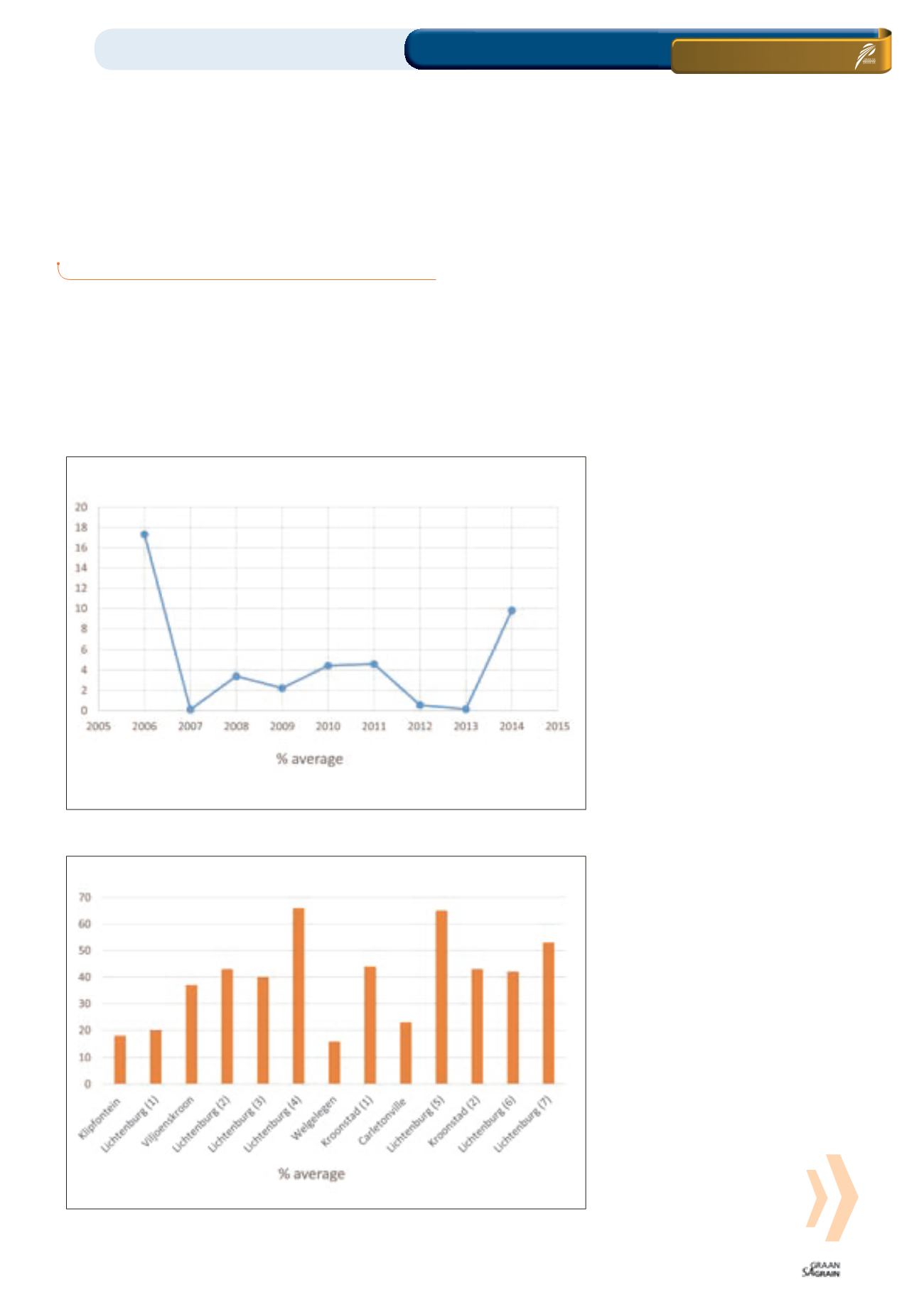

Sclerotinia disease of sunflower:
A devastating pathogen
S
clerotinia head and stalk rots of sunflower are caused by
a fungus known as
Sclerotinia sclerotiorum
. This fungus
is able to infect a wide range of field crops including soy-
beans, beans, canola and lupines as well as various
vegetable crops.
Sclerotinia stem rot of sunflower is not a direct major threat to
sunflower production in South Africa. However, Sclerotinia head
rot can cause major damage, particularly in early-planted crops that
ripen in cool, wet conditions. Sclerotinia head rot is not limited to the
major sunflower production areas (Limpopo, North West Province,
Mpumalanga and Free State), but can also occur in other provinces
where sunflower is grown.
The Department of Agriculture, Forestry and Fisheries’ Crop
Estimates Committee report this last season indicated seasonal
variation in sunflower production areas affected by Sclerotinia
head rot (
Graph 1
and
Graph 2
). According to this report the 2006
and 2014 seasons showed the highest
percentage area affected by Sclerotinia
head rot. And this fluctuation in percent-
age area affected by Sclerotinia head rot
observed from 2006 - 2014 is strongly
influenced by seasonal changes in envi-
ronmental climatic conditions. Specific
producers reported up to 100% infections
this last season which resulted in extreme-
ly high financial losses.
Results from the Crop Estimates Commit-
tee correlate with the sunflower disease
severity surveys carried out by the ARC-
Grain Crops Institute (ARC-GCI) in Potchef-
stroom during the 2012/2013 and 2013/2014
seasons. The report from the severity
survey indicated that Sclerotinia head rot
was only found in the Delmas area (30%)
in 2012/2013 whereas in 2013/2014 the
disease spread to all major sunflower pro-
duction areas causing epidemics of up to
60%, with the North West Province being
hit the hardest.
The 2012/2013 season was a dry season
compared to the 2013/2014 season, hence
the huge differences in Sclerotinia disease
epidemics and distribution.
How to identify the
Sclerotinia diseases
Sclerotinia head rot
The fungus infects the back of the head
during flowering and as the disease pro-
gresses, the tissues become soft, light
brown and spongy (
Photo 1
). This infection
extends into the developing head and
down the stalk and eventually only the
fibrous strands at the back of the head and
upper stalk remains (
Photo 2
). The infected
seed at the front of the head eventually
falls out of the head due to the sheer
weight of the infected seed. Large, black
sclerotia (small, bird-dropping like, black
particles) (
Photo 3
) develop below the
seed layer and around the seeds.
Sclerotinia stem rot
Initial symptoms are sudden wilting of the
95
March 2015
MOSES RAMUSI
and
BRADLEY FLETT,
ARC-Grain Crops Institute
Graph 1: Percentage area planted affected by Sclerotinia from 2006 to 2014.
Department of Agriculture, Forestry & Fisheries, 2014
Graph 2: Percentage average severity and distribution of Sclerotinia head rot for the 2013/2014 sea-
son obtained from various localities.
ON FARM LEVEL
Integrated pest control
Sclerotinia / Sunflower / Head rot / Stalk rot

















